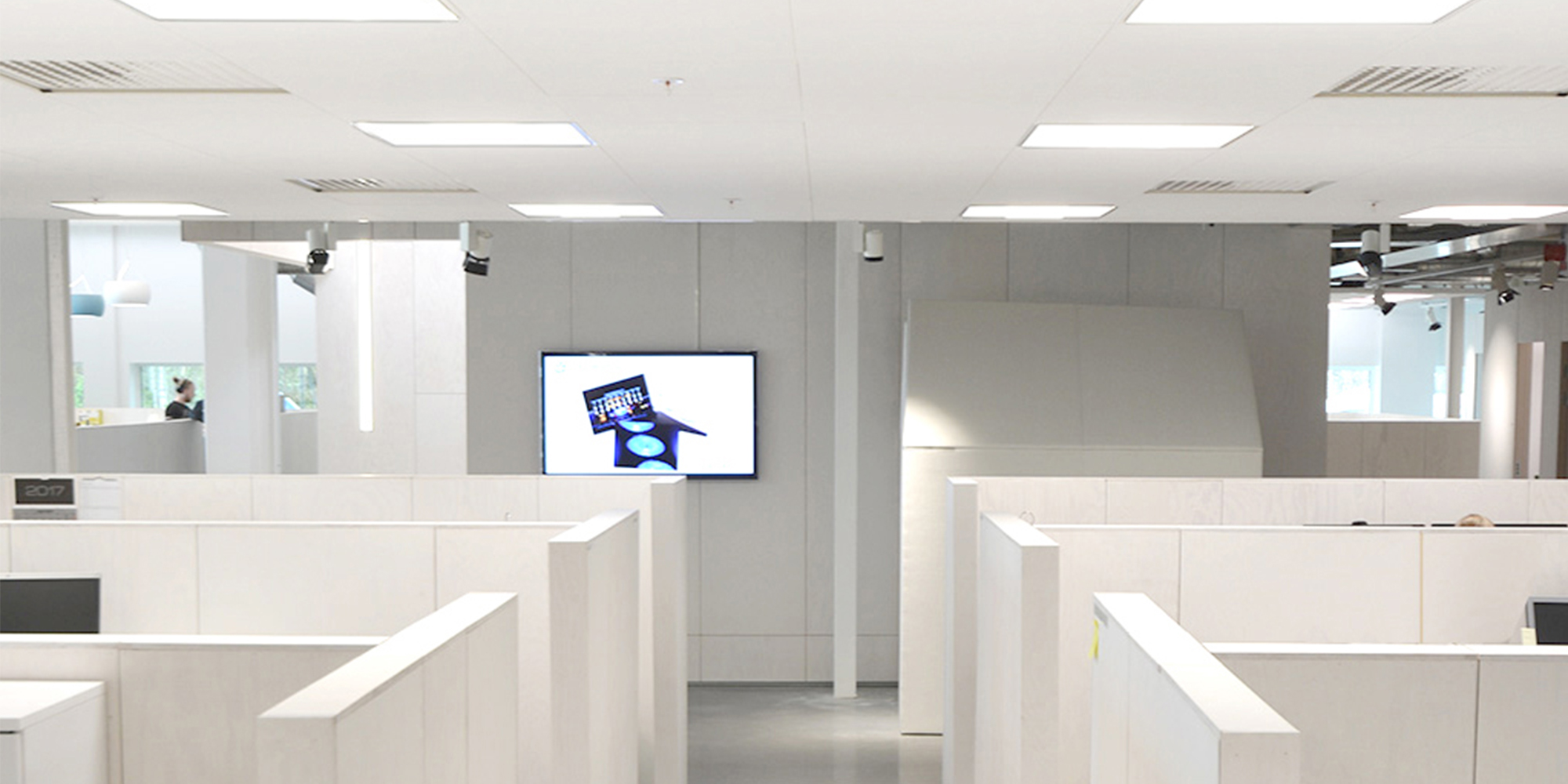
How to put human centric lighting into practice
Do you have neck and shoulder pain? It could be caused by bad lighting. Up to 40 percent of the population is sensitive for visual stimuli like glare. ”To improve health, reduce eyestrain, headache and musculoskeletal strain – such as neck and shoulder pain – the visual environment needs to be glare free, flicker free (including temporal light modulation) and have enough illuminance to perform the work task”, says Hillevi Hemphälä, one of the world's leading researchers in visual ergonomics.
During Hillevi Hemphälä's first working week as a trained optician, a young, female student asked for help with a vision examination. She often had headaches and suspected refractive errors.
”I did all the examinations possible. But I found nothing wrong with her vision at all! So, I asked her in what kind of situations she usually experienced discomfort. She told me that she always got headaches while reading in the library or attending lectures. When studying at home, drinking tea and reading in the light of a lit candle, everything felt great. I began to suspect that she was an extremely light sensitive person who couldn’t cope with glare”, Hillevi tells.
”I advised her to get a pair of gradual-colored sunglasses and to use them with a cap or hat with a brim during the lectures. A few weeks later she came back and told me that the headache was gone. That's when I decided to learn more about lighting!”
After a studying Lighting Design at Jönköping University Hillevi went on to earn a doctors’ degree at Design Sciences in Lund with a specialization in visual ergonomics. Today, she is associate senior lecturer at the Department of Ergonomics and Aerosol Technology at Lund University. She is also one of the few opticians in the world who do research in lighting.
 "In my research we have established a connection between eye problems and pain in the neck and shoulders. The people who reported eye problems also had three times as much musculoskeletal problems." Hillevi Hemphälä, senior lecturer Department of Ergonomics and Aerosol Technology, Lund University
"In my research we have established a connection between eye problems and pain in the neck and shoulders. The people who reported eye problems also had three times as much musculoskeletal problems." Hillevi Hemphälä, senior lecturer Department of Ergonomics and Aerosol Technology, Lund University
Lack of knowledge
Unfortunately, the common knowledge about visual ergonomics and how the visual environment should be designed from a human centric perspective is very low, says Hillevi. Too often, lighting environments in schools and at offices are planned as heavy glaring covers of light, which results in many students and employees having health problems. Most of us, have no reference of what good light is, making it hard for us to evaluate and change our visual environments.
”We often think that the headache that develops during the work day is caused by poor eyesight and that you need new glasses, when in fact it is often poor and dazzling lighting that affects your vision.”
Hillevi’s research suggests that between 20-40 percent of the population is more sensitive to visual stimuli. Light sensitivity is also more common among women than among men.
”In my research we have established a connection between eye problems and pain in the neck and shoulders. The people who reported eye problems also had three times as much musculoskeletal problems.”
Back to basics
But how do you do to become more aware of your visual environment?
”Try holding your hands like a screen over your eyes, or put on a cap. If you find that there is a positive difference, then something in the visual environment is wrong, and probably it is light related.”
If you need a temporary solution, you can put up an ordinary outdoor parasol over your workplace, but of course, it won’t do in the long run. By addressing both any eye problems and the visual environment, you create the best conditions for increased health and well-being.
In order to create a good lighting environment, one must take the whole context into account. Lighting planning must be done based on our workplaces – rolling out a lux carpet over the room just won’t do it. If not careful, the lighting will become too strong for the eye. The human vision is developed for a natural environment, with the sky and the horizon with its smooth transitions, as a reference. Our eyes do not approve to strong contrasts, blacks and white.
In the era of large LED, ceiling mounted panels, we should consider going back to basics. By choosing a pendant with indirect/direct 70/30 light distribution over the desk you will get a comfortable lighting environment where the indirect lighting to the ceiling will help smooth out contrasts and prevent glare.
For those taking visual comfort at the workplace seriously, researchers at Lund University, Gävle University and KTH have developed the risk assessment tool VERAM. About 70 ergonomists at the Swedish occupational health service have been trained to use the tool and provide good light ergonomics to Swedish workplaces.
Is there still a flicker problem?
Glare is still a highly discussed topic in the lighting industry. But have you heard anyone talking flicker lately? In the days of the T8 and T5 fluorescent tubes, minimizing flicker was high up on the agenda for all serious players. One might wonder if LED was the end of flicker? Actually, the problem can be worse than ever, says Hillevi. The flicker is still there, it just changed character.
”When the light flickers visibly it is called “flicker” but when it is not visible it is called temporal light modulation, you might see the light flickering during eye-saccades or if a flickering object is moving in the visual field. When you cannot detect it - it is commonly called non-visual flicker or subliminal flicker, but the correct terminology is temporal light modulation, and the effects of it such as light arrays is called temporal light artefacts.”
”The flicker from LEDs can have higher frequency and modulation, making it not visible. The old kind of fluorescent tubes had conventional ballasts that switched the light on 100 times per second (in Europe) resulting in a soft 100 Hz sinus curve with a modulation of about 50 percent. LED technology is digital, meaning you in the worst case can get a square waved curve of a 100 Hz that is either on or off. In many cases there is a fluorescent that causes a longer cool of period, giving a softer waved curve, even sometimes a sinus curve, with a lower modulation. Sometimes the dimmer function of the LED drivers consists of pulse width modulation, PWM, causing an extended “off-period” that leads to higher modulation. The higher the modulation, the easier it is for the eye to detect it within some ranges. Dimming with PWM causes more reaction from us humans. According to a study, LED-flicker at 1,900 herz can also result in an uncomfortable lighting phenomenon called phantom array where the eye perceives a light trail from the light source”, Hillevi explains.
No rocket science
Many LED light sources are great and the technology has great potential, she states.
The problem is that we usually do not have drivers that are good enough to produce a flicker free or a frequency free LED light. To be on the safe side, we would need drivers with a frequency of more than 3,000 Hz, preferably more than 20000 Hz. Today, many suppliers offer 300-400 Hz.”
People who have a high sensitivity to visual stimuli are, unsurprisingly, also more sensitive to flicker.
”In our CCF-studies (Critical Flicker Frequency) we found out that about 24 percent of the participants were sensitive to flicker from LED lighting. This group suffered both eye problems and headaches after being exposed for an hour”, says Hillevi.
”What mostly surprises me, is that this is by no means rocket science. The problem can easily be solved, but I think there’s a lack of knowledge within the industry. Innovation Skåne has developed a completely flicker-free driver, it has no frequency at all. The device is easy to manufacture and it could not be patented, it is practically an open source, you can just ask for the CAD file. The solution is right in front of your eyes!”
TEXT AMELIE BERGMAN
PHOTO EMELIE ASPLUND, MELKER DAHLSTRAND/IMAGEBANKSWEDEN, ROBERT OLSSON

